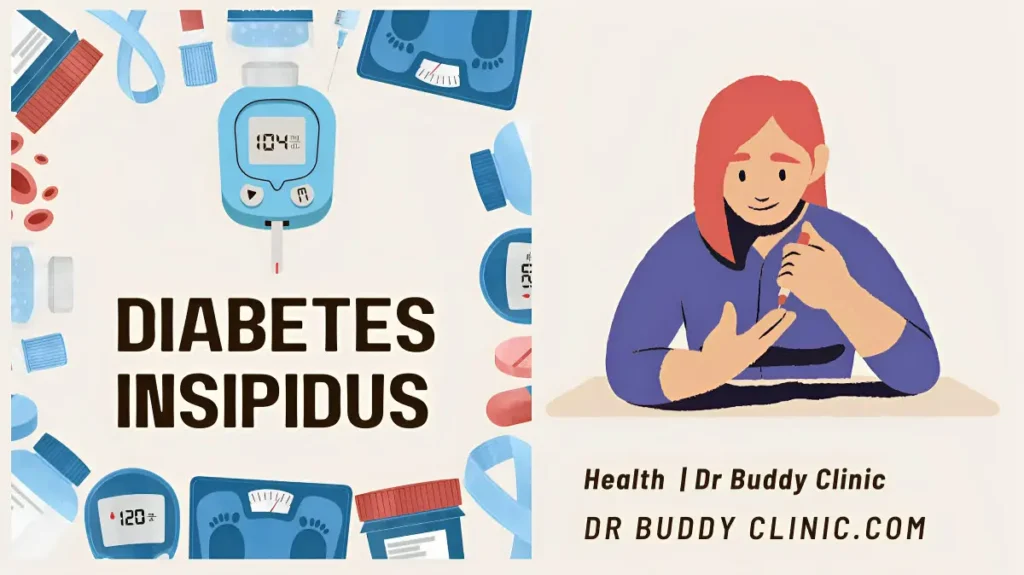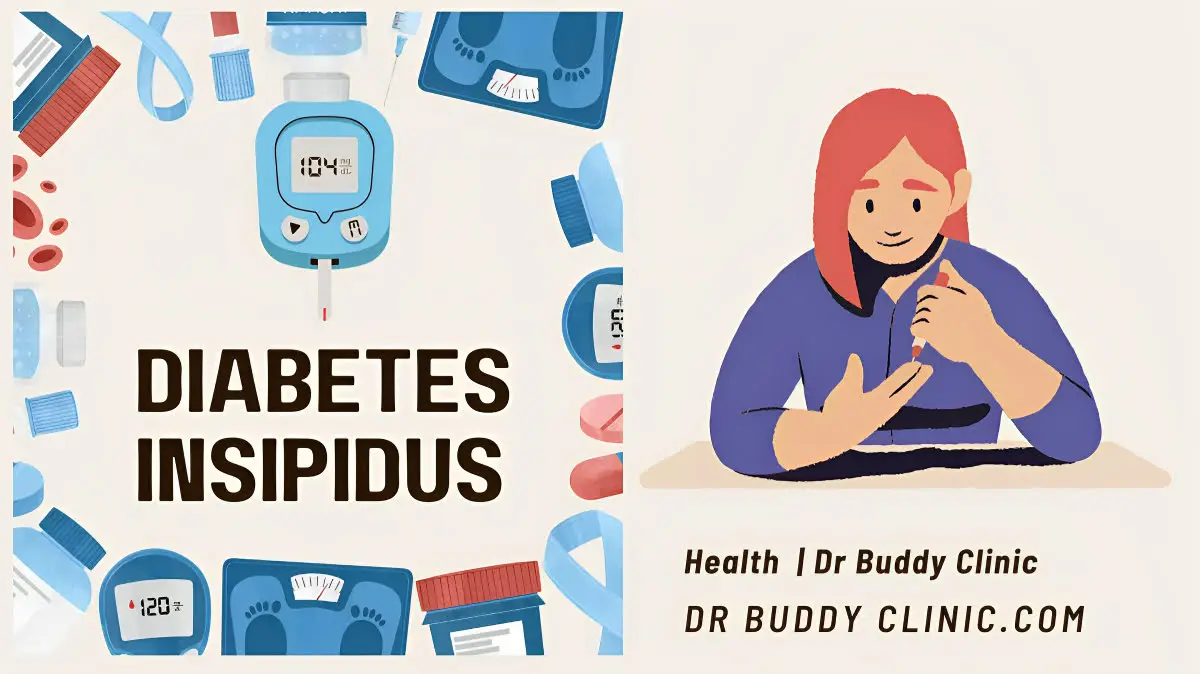Table of Contents
Introduction
Welcome to our comprehensive guide on diabetes insipidus, a rare but important medical condition that affects the regulation of body fluids. In this blog post, we will explore the ins and outs of diabetes insipidus, including its symptoms, causes, treatment options, and more. Whether you or a loved one has been diagnosed with diabetes or you simply want to enhance your understanding of this condition, we’ve got you covered. So, let’s dive in and unravel the mysteries surrounding diabetes insipidus.

Defination of Diabetes Insipidus
What is Diabetes Insipidus ?
Diabetes insipidus (DI) is a relatively rare disorder that disrupts the balance of fluids in the body. It is characterized by excessive thirst and the production of large volumes of diluted urine. Unlike diabetes mellitus, which involves problems with insulin production or utilization, Insipidus is primarily caused by inadequate production or utilization of the hormone called vasopressin (antidiuretic hormone or ADH). Vasopressin is responsible for regulating the body’s water balance by controlling how much water is reabsorbed by the kidneys.
Types of DI :
There are three main types of diabetes :
Central Diabetes Insipidus :
Central DI is the most common form of diabetes insipidus. It occurs when the body’s production of vasopressin is insufficient or completely absent due to a problem with the hypothalamus or the pituitary gland. This could be the result of trauma, tumors, infections, or certain genetic conditions.
Nephrogenic Diabetes Insipidus
Nephrogenic DI is a condition where the kidneys fail to respond appropriately to vasopressin, leading to impaired water reabsorption. This form of insipidus diabetes can be caused by genetic factors, certain medications, and certain kidney disorders.
Gestational Diabetes Insipidus :
Gestational DI is a rare form of diabetes that occurs temporarily during pregnancy. It is usually caused by an enzyme produced by the placenta that breaks down vasopressin, resulting in water imbalance.
Causes
Diabetes can stem from various causes, depending on the type:
- Central Diabetes Insipidus Causes: Central diabetes insipidus is often caused by damage to the hypothalamus or the pituitary gland. These damages can be due to head injuries, brain tumors, infections (such as meningitis or encephalitis), and even certain genetic conditions like Kallmann syndrome.
- Nephrogenic Diabetes Insipidus Causes: Nephrogenic diabetes insipidus is caused by the kidneys’ inability to respond to vasopressin properly. This can be a result of certain medications, chronic kidney disease, high calcium or low potassium levels, or genetic factors.
- Gestational Diabetes Insipidus Causes: The placental enzyme responsible for breaking down vasopressin during pregnancy can lead to temporary diabetes insipidus. Once the pregnancy is over, hormone levels generally return to normal, resolving the condition.
It’s important to consult with your healthcare professional to accurately diagnose the underlying cause of diabetes as treatment plans may vary.
Symptoms and Diagnosis
Signs and Symptoms :
The symptoms of diabetes can vary depending on the type and severity of the condition. Common signs and symptoms may include:
- Excessive thirst (polydipsia): Individuals with diabetes often experience unquenchable thirst, no matter how much they drink.
- Excessive urination (polyuria): Large amounts of diluted urine are produced, leading to frequent urination.
- Dehydration: If fluid intake doesn’t match the amount lost through urine, dehydration can occur, resulting in dry mouth, dry skin, and fatigue.
- Nocturia: Frequent urination during the night.
- Weakness and confusion: Dehydration and electrolyte imbalances can cause weakness, fatigue, and confusion.
- Weight loss: Rapid weight loss may occur if fluid intake is insufficient.
Diagnose :
To diagnose DI, medical professionals employ several tests, including:
- Water Deprivation Test: In this test, the patient is asked to limit fluid intake for a certain time period while their fluid output and weight are monitored. This helps identify if excessive urination results from kidneys responding poorly to vasopressin or from another cause.
- Urinalysis: Analyzing a urine sample allows healthcare providers to detect abnormalities, such as dilutional effects and sugar content.
- Blood Tests: Blood tests can reveal hormone levels, electrolyte imbalances, and other factors that may contribute to the diagnosis of diabetes.
- MRI or CT Scan: Imaging tests like magnetic resonance imaging (MRI) or computed tomography (CT) scan may be performed to identify any structural abnormalities in the brain or kidneys that could be the underlying cause of diabetes.
Proper diagnosis is crucial for developing an effective treatment plan for diabetes.
Treatment and Management
While there is no cure for diabetes, various treatment options are available to manage the condition effectively. Treatments aim to alleviate symptoms and maintain fluid balance in the body. The chosen approach depends on the type and severity of diabetes.
Medications and Hormone Therapy
- Desmopressin (DDAVP): Desmopressin, a synthetic version of vasopressin, often helps individuals with central diabetes insipidus. It can be administered orally, nasal spray, or injection, helping regulate fluid balance in the body.
- Indomethacin: Indomethacin, a nonsteroidal anti-inflammatory drug (NSAID), is sometimes prescribed for individuals with nephrogenic diabetes insipidus as it can reduce urine output by decreasing blood flow to the kidneys.
- Thiazide Diuretics: These diuretics, often used to treat high blood pressure, can also be beneficial for managing nephrogenic diabetes insipidus. They help the kidneys retain more water, reducing urine output.
Lifestyle Changes
In addition to medical treatments, certain lifestyle modifications can assist in managing diabetes :
- Proper Hydration: Drinking enough fluids to compensate for excessive urine output is essential.
- Low-sodium Diet: Reducing sodium intake can alleviate excessive thirst and prevent electrolyte imbalances.
- Avoiding Trigger Medications: Certain medications, such as lithium or antiviral medications, may exacerbate symptoms of diabetes insipidus. Consult with a healthcare professional to assess and adjust medications if necessary.
Coping Strategies
Managing diabetes can be challenging, but adopting coping strategies can significantly improve the quality of life:
- Educating Loved Ones: Sharing knowledge about the condition with family, friends, and coworkers can foster understanding and support.
- Carrying Identification or Medical Alert Bracelet: In case of an emergency, wearing an identification or medical alert bracelet ensures prompt and appropriate care.
- Monitoring Fluid Intake and Output: Keeping track of fluid intake and urine output can help individuals maintain the optimal fluid balance.
Complications and Risk Factors
Complications :
If left untreated or improperly managed, diabetes can lead to various complications:
- Dehydration: Constant thirst and excessive urine output can result in dehydration if fluid intake doesn’t match the loss.
- Electrolyte Imbalances: Water and electrolyte imbalances can cause electrolyte disorders, such as low sodium levels (hyponatremia).
- Fatigue and Weakness: Dehydration and electrolyte imbalances may cause fatigue, weakness, and overall lethargy.
- Increased Risk of Urinary Tract Infections: Frequent urination may increase the risk of developing urinary tract infections.
Risk Factors :
Several factors could increase the risk of developing diabetes :
- Head Trauma or Brain Surgery: Injuries or surgical procedures involving the brain can damage the hypothalamus or pituitary gland, leading to diabetes.
- Structural Abnormalities: Congenital or acquired structural abnormalities in the brain or kidneys may interfere with the hormone functions, resulting in diabetes.
- Certain Genetic Disorders: Conditions like Kallmann syndrome or Wolfram syndrome are associated with an increased risk of developing diabetes.
If any risk factors or symptoms are present, it is important to seek medical advice for proper diagnosis and guidance.
Frequently Asked Questions
- Can diabetes insipidus be cured?
Unfortunately, there exists no cure for diabetes insipidus at present. However, with proper management and treatment, individuals with diabetes insipidus can lead normal lives. - Are diabetes insipidus and diabetes mellitus the same thing? No, diabetes insipidus and diabetes mellitus are two distinct conditions. While both involve the regulation of fluids in the body, insipidus is caused by a deficiency or resistance to vasopressin, whereas mellitus involves problems with insulin production or utilization.
- Is diabetes insipidus a common condition? No, diabetes insipidus is considered a rare disorder. However, it is important to consult a healthcare professional if symptoms or risk factors are present.
- Can diabetes insipidus be inherited? Genetic factors can contribute to the development of diabetes insipidus, particularly in the case of nephrogenic diabetes insipidus.
- Is diabetes insipidus reversible? Depending on the underlying cause, diabetes insipidus can sometimes be reversible. For example, gestational diabetes insipidus typically resolves after pregnancy.
Conclusion
In conclusion, diabetes insipidus is a rare but important disorder that affects the body’s ability to regulate fluids, with symptoms including excessive thirst, frequent urination, and dehydration. By understanding the symptoms, causes, treatment options, and complications associated with diabetes , individuals can work with healthcare professionals to develop effective management strategies. While there is no cure for this condition, the right combination of medications, lifestyle changes, and coping strategies can help individuals with diabetes live full and fulfilling lives. If you suspect you or someone you know may have diabetes , consult your medical professional for accurate diagnosis and appropriate management.
